“The entertainment began with a discharge of 13 cannons at 4 o’clock in the afternoon.”
The Grand Alliance Ball – Sunday, February 18, 1779 , Pluckemin, New Jersey
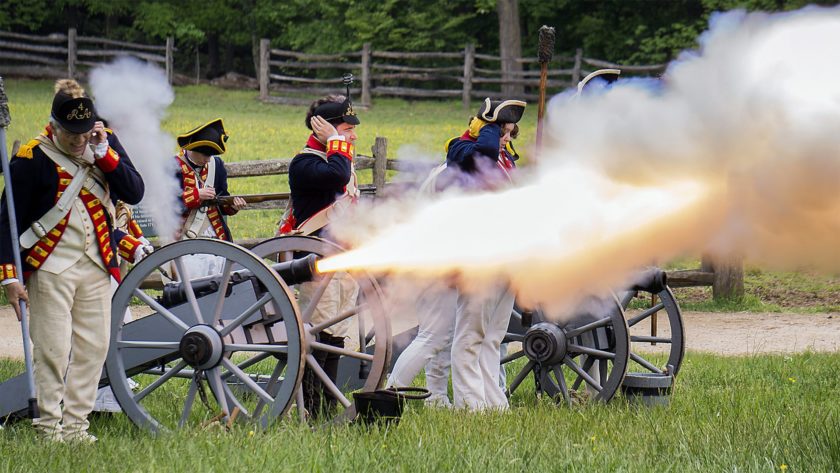
Sunday, February 18, 1779 , Pluckemin, New Jersey
One of the most noted events in Pluckemin was The Grand Alliance Ball of 1779 in Pluckemin.(Sometimes spelled Pluckamin) General Washington and 400 others attended the celebration held on the grounds of the Boylan House in 1779. The ball celebrated the first anniversary of the alliance with France, which ended in victory for the allies at Yorktown. The ball was attended by more than 400 dignitaries.

George and Martha Washington attended the ball that took place on grounds of what was the John Boylan home (see left), near the northwest side of the Cornelius Eoff farm. (Somerset County Historical Quarterly October 1917) A fuller description of the Grand Alliance Ball in Pluckemin can be found in General Knox’s letters. The Ball is also part of George Washington’s writings that are at the Library of Congress and now part of the American Memory database. This letter is one of 20 letters from Washington that mention Pluckemin or Pluckamin.
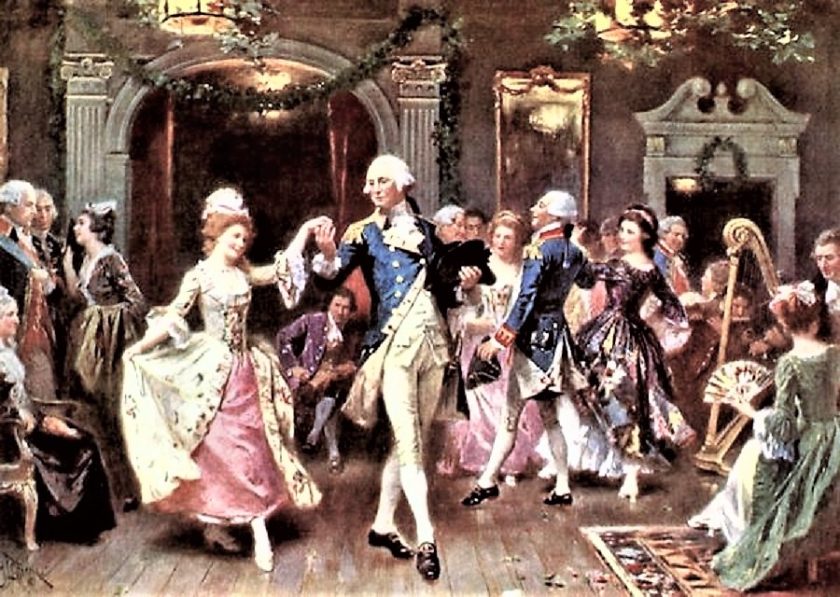
“Fireworks were devised by Colonel Stevens and set off from the top of the frame. The entertainment began with a discharge of 13 cannon at 4 o’clock in the afternoon, which was the signal for the commencement of the supper at which many toasts were drunk to patriotic sentiments. After the fireworks display, the ball was opened by Washington and Mrs. Knox in the Academy building in the village of Pluckamin.”
General Washington Letters
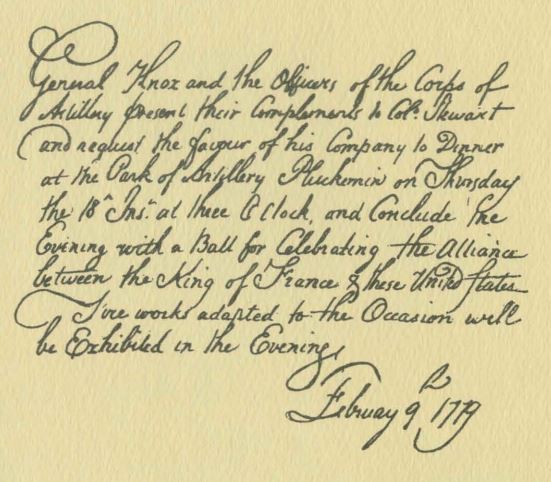
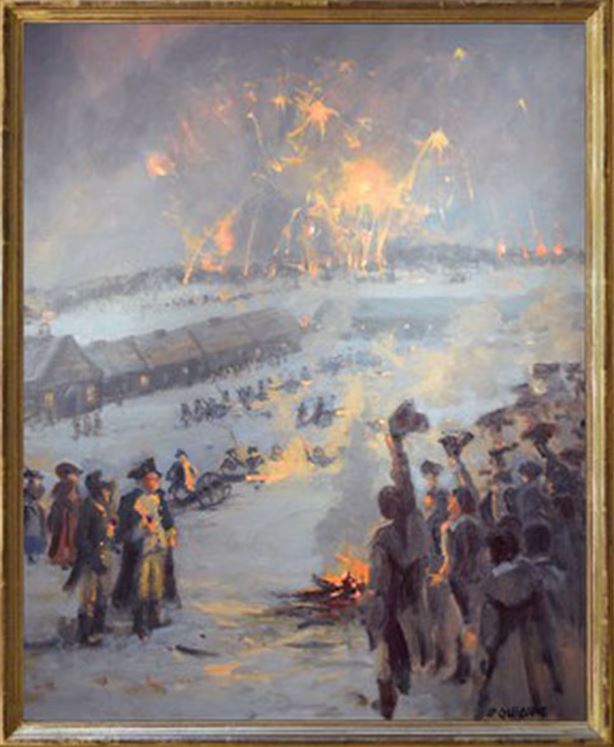
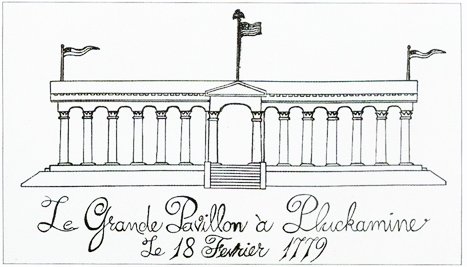
Grand Illuminated Paintings Showcased
- The 1st arch, on the right, represented the commencement of hostilities at Lexington, with this inscription: ‚ÄėThe scene opened.‚ÄĚ
- 2nd ‚Äď British Clemency. Represented in the burning of Charlestown, Falmouth, Norfolk, and Kingston.
- 3rd ‚Äď The separation of America from Britain. A magnificent arch broken in the centre, with this motto: ‚ÄėBy your tyranny to the people of America you have separated the wide arch of an extended empire.‚Äô
- 4th ‚Äď Britain represented as a decaying empire, by a barren country, broken arches, fallen spires, ships deserting its shores, birds of prey hovering over it‚Äôs moldering cities, and a gloomy setting sun. Motto: ‚ÄėThe Babylonian spires are sunk, Achaia, Rome, and Egypt mouldered down; Time shakes the stable tyranny of thrones, And tottering empires crush by their own weight.‚Äô
- 5th ‚Äď America represented as a rising empire. Prospect of a fertile country, harbors and rivers covered with ships, new canals opening, cities arising amist woods, splendid sun emerging from a bright horizon. Motto: ‚ÄėNew worlds are still emerging from the deep, The old descending in their turns to rise.‚Äô
- 6th ‚Äď A grand illuminated representation of LOUIS the sixteenth. The encourager of letters, the supporter of the rights of humanity, thally and friend of the American people.
- 7th The centre arch. The Father in Congress. Motto: ‚ÄėNil desperandum reipublicae.‚Äô
- 8th The American Philosopher and Ambassador extracting lightning from the Clouds.
- 9th The battle near Saratoga, 7th Oct., 1777.
- 10th ‚Äď The Convention of Saratoga.
- 11th ‚Äď A representation of the sea-fight, of Ushant, between count D‚ÄôOrvilliers and Admiral Keppie.
- 12th ‚Äď Warren, Montgomery, Mercer, Wooster, Nash, and a crowd of heroes who have fallen in the American contest, in Elysium, receiving the thanks and praises of Brutus, Cato, and those spirits who in all ages have gloriously struggles against tyrants and tyranny. Motto:‚Äô Those who shed their blood in such a cause shall live in and reign forever.‚Äô
- 13th ‚Äď Represented peace, with all her train of blessings. Her right hand displaying an olive branch; at her feet lay the honors of harvest; the background was filled with flourishing cities; ports crowded with ships, and other emblems of an extensive empire and unrestrained commerce.
When the fireworks were finished, the company returned to the academy, and concluded the celebration by a very splendid ball. The whole was conducted in a style and manner that reflects great honor on the taste of the managers. The news announced to congress from the Spanish branch of the house of Bourbon, arriving at the moment of celebration, nothing could have so opportunely increased the good- humor of the company, or added to those animated expressions of pleasure which arose on the occasion.
February 28, 1779, General Henry Knox wrote a letter to his brother describing the Grand Alliance Ball
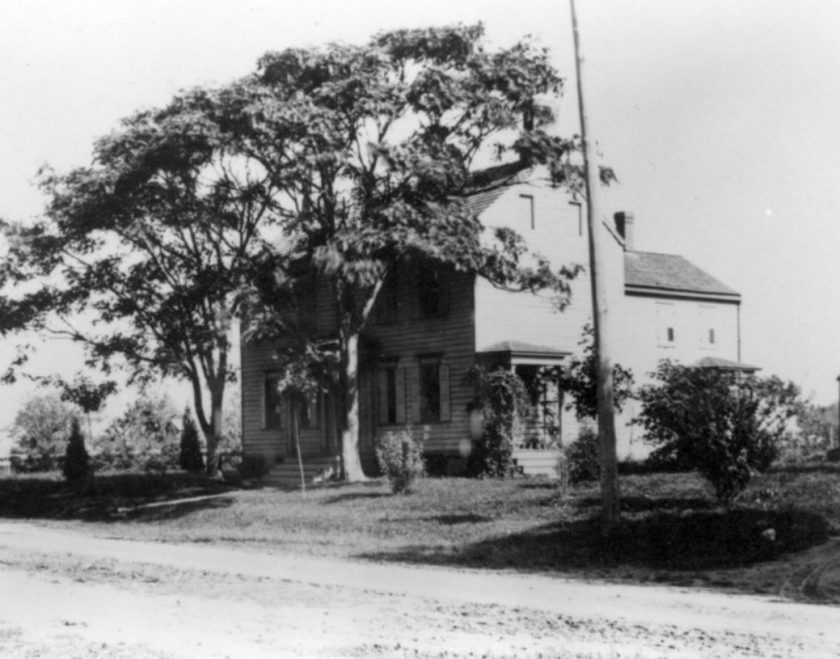
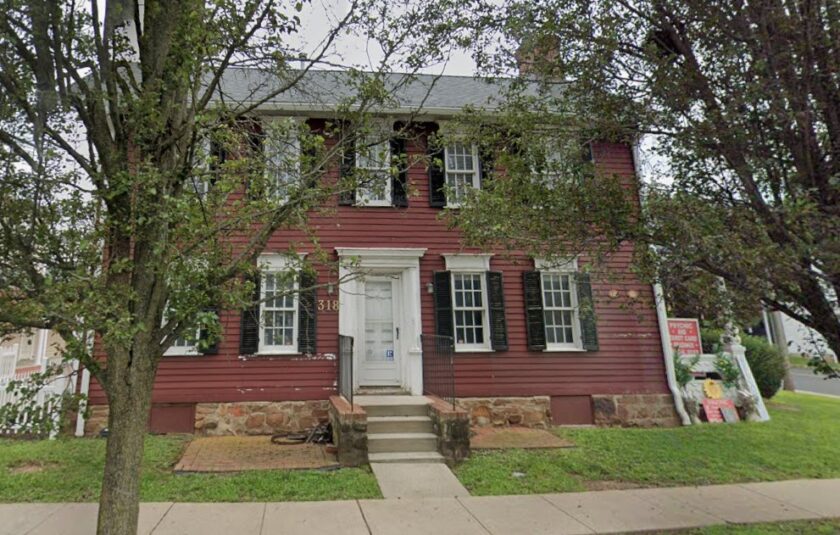
“We had above seventy ladies, all of the first ton in the State, and between three and four hundred Gentlemen. We danced all night–an elegant room, the illuminating fireworks were more than pretty.”The entertainment was given by the artillery corps, which erected a temple, or frame, of 13 Corinthian arches, about 100 feet in length and proportionally high, each arch containing an illuminated painting emblematic of the Revolution.“
February 28, 1779, General Henry Knox wrote a letter to his brother describing the Grand Alliance Ball
WASHINGTON OPENS THE BALL
Mr. Lossing quotes, “The aged widow of Alexander Hamilton as having said that Washington never danced; that¬†though he frequently attended balls and assemblies, and always¬†honored some lady with his hand, he merely walked through the figures. The general’s evening dress is said to have been of black velvet, with knee and shoe buckles, a steel rapier, and his hair, thickly powdered, drawn back from the forehead, and gathered in a black silk bag adorned with a rosette. He opened the ball with Mrs. Knox. Cannot you see him, with his imperturbable face and kindly, grave mien, as, holding aloft his partner’s hand, with all the graceful dignity of a nobleman of nature he steps with her down the room. Another partner of the commander- in-chief was a daughter of Judge Linn, and more than one beauty of that period, now sleeping under crumbling headstones in Pluckamin and other churchyards, was made happy, in after- years, by the remembrance that she danced that night with the ” Father of his Country.”
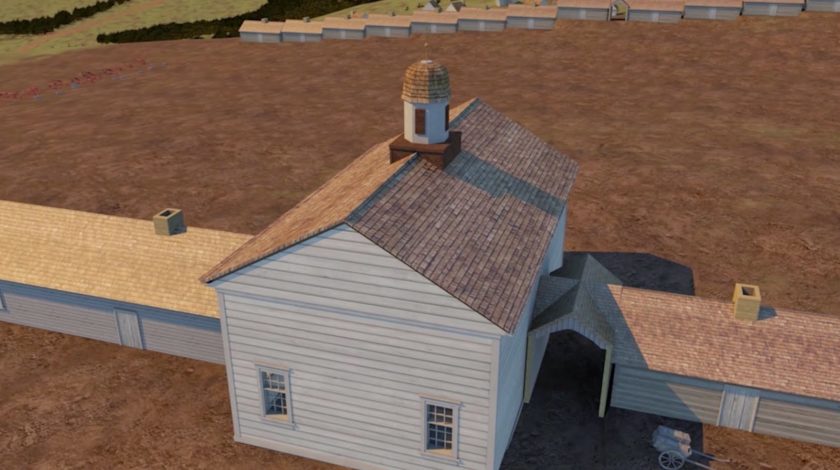
The society reporter is not, as is so generally supposed, a modern feature of journalistic enterprise. He was an institution in the last century, and the one who figured among the guests at this Pluckemin fete was evidently not far behind his brothers of the modern press in liveliness of fancy.
In the ” Pennsylvania Packet” of the sixth of March, he describes Mrs. Greene, Mrs. Knox, and the other ladies who surrounded Mrs. Washington as being a ” circle of brilliants, the least of which was more valuable than the stone which the King of Portugal received for his Brazilian possessions.” I cannot refrain from giving a further extract from this Revolutionary ” Jenkins’s ” account of the festivities on this anniversary occasion. It is interesting as showing that in those patriotic days, the affairs of the country even gave color and direction to the pleasantries and ballroom badinage of young girls and gallants :
‚ÄĒ As it is too late in the day for me to follow the windings of a fiddle, I contented myself with the conversation of some one or other of the ladies during the interval of dancing.I was particularly amused with the lively sallies of a Miss * * *. Asking her if the roaring of the British lion in his late speech did not interrupt the spirit of the dance ; ” Not at all,” said she, ” it rather enlivens, for I have heard that such animals always increase their howlings when most frightened. And do you not think,” added she, “you who should know mere than young girls, that he has real cause of apprehension from the large araia Loading…Loading… ments and honorable purpose of the Spaniard ?” ‘‚ÄĘ So,” said I, ” 700 suppose that the King of Spain acts in politics us the ladies do in affairs of love, smile in a man’s face, while they are spreading out the net which is to entangle him for life.” ” At what season,” replied the fair, with a glance of ineffable archness, “do men lose the power of paying such compliments?”
I do not recollect that I have ever been more pleased on any occasion, or in 10 large a company. There could not have been less than sixty ladies. Their charms were of that kind which give a proper determination to the spirits and permanency to the affections. More than once I imagined myself in a circle of Sammies, where beauty and fidelity were made subservient to the interest of the State, and reserved for such citizens as had distinguished themselves in battle. Is it that the women of Jersey by holding the space between two large cities have continued exempt from the corruptions of either, and preserved a purity of manners superior to both ? Or have I paid too great attention to their charms and too little to those imperfections which observers tell us are the natural growth of every soil ?
General and Mrs. Knox tasted sorrow as well as pleasure while living in the Van der Veer house. About twenty-five feet west of the Reformed Dutch church, a tombstone is still to be seen, upon which is the following inscription: Under this stone are deposited the Remains of Julia Knox, an infant who died the second of July, 1779. She was the second daughter of Henry and Lacy Knox, of Boston, in New England.
Mrs. Knox was, in all the mother of ten children. Seven of them may be said to have been laid on the altar of her country, as that number died in infancy ; due without doubt to the excitements and severe bodily and mental strain incidental to campaigning. Bedminster traditions preserve an unhappy story connected with the death of this Revolutionary babe. Notwithstanding that Knox was in the township defending the homes and liberties of the people, the consistory of the Reformed Dutch church refused to allow this little one to be buried in the churchyard. In their ignorance and superstition the Dutch fathers considered the fact of Knox being a member of the Congrega- , tional church of New England sufficient to warrant their refusing his child a sepulchre. The general’s host, old Jacobus Van der Veer ‚ÄĒ himself one of the consistory ‚ÄĒ was very indignant at the stand taken by his co- trustees. He, poor man, had suffered from the same bigotry. A few years before, on the death of an insane daughter a burial place had been denied his child ; this, too, in the face of the fact that the church-grounds had been a gift to the congregation from THE STORY OF AN OLD FARM. Loading…Loading… STEUBEN AS A DISCIPLINARIAN. 471 the man they were treating so harshly. The worthy elders reasoned that the girl’s infirmities would endanger her salvation in the next world, consequently her body in this one could not be permitted to crumble into dust among those of the elect. Van der Veer buried his daughter in a field just beyond the line of the ” God’s acre.” He is said to have taken Knox by the hand, and leading him to the lonely grave outside the fence, ejaculated with a choking voice, ” Gen’ral, this is my ground, bury your child here.” The prejudice of the church people seems to have lessened, as a few years later the fence was moved, so that the burial-ground now includes the once excluded graves of the children of honest old Jacobus Van der Veer and the brave Evolutionary soldier.
From This Old Farm (Book) The Story of an Old Farm or Life in New Jersey in the Eighteenth Century by Andrew Mellick, Jr. – The Unionist Gazette, Somerville, NJ (1889) pgs. 469 – 470.
Anniversary of the Anniversary – 1913
“An Anniversary Celebration at Pluckemin seventy-five of the most patriotic citizens of Pluckemin and vicinity met in the Presbyterian parsonage on Friday evening, February 21, to commemorate one of the most notable social events in the early history of the place. This event was the grand fete and ball given February 18, 1779, in honor of the first anniversary of the French Alliance, which was attended by General and Lady Washington, and a distinguished company. The parsonage was selected as the most appropriate place for the celebration, as it faces the old camp ground, which was beautifully located on a high piece of ground in the northern part of the village. The decorations on this occasion would have done honor to the first celebration. Andrew Compton, who owns and resides in the house where Eleanor Boylan entertained General and Lady Washington, appeared as the stately Commander-in-chief and Mrs. Martha Powelson assumed the honors of Lady Washington. The distinguished couple served bountiful refreshments from a large center table lighted with tallow candles, and the blue ware used had seen service during the trying days of the American Revolution. The young waitresses appeared in the gowns of their great grandmothers. Revolutionary tales were told, and the occasion will long be remembered as one greatly enjoyed by all.”
Somerset County Historical Quarterly, Vol. II, No. 2, April 1913, p. 155-156.) Two hundred years later on February 18, 1997 at the Bedminster Inn (also known now as Willies Tavern) held a bicentennial dinner celebration was attended by guests wearing 18th century costumes. A fireworks display also took place near the Park of Artillery (the Pluckemin Artillery Cantonment).
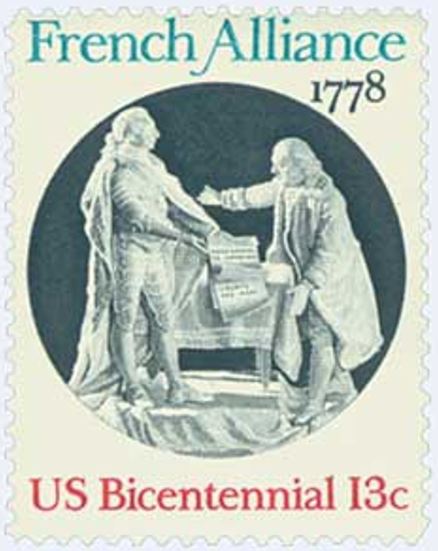
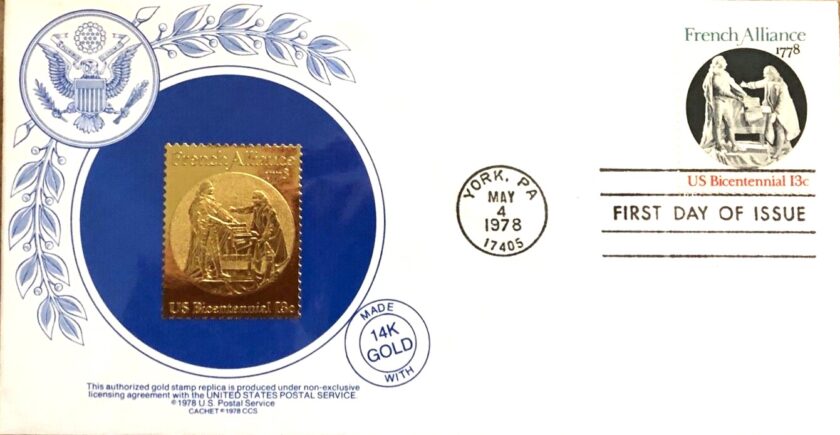
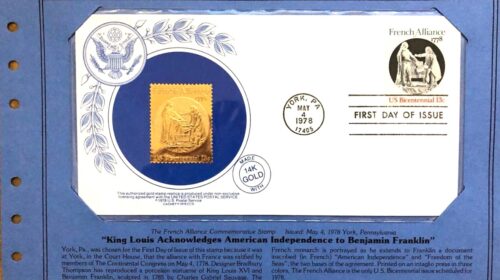
What are Others Reading This Week? Top 5 MLH Posts Right Now
Related Research Posts
- Crossroads of the American Revolution ‚Äď Click Here
- National Park Service ‚Äď Click Here
- The Jacobus Vanderveer House/Museum ‚Äď Click Here


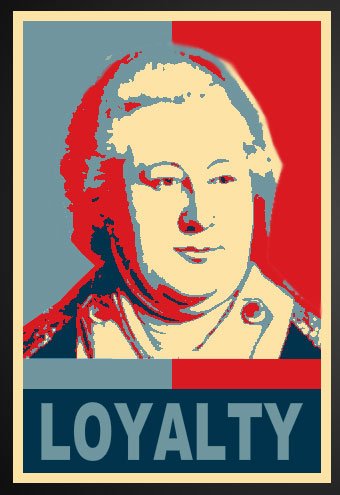





Fascinating article about the ball that was held during the revolution and that General and Mrs. Washington Actually stayed overnight in the Boylan House in Pluckemin.
My parents owned the Boylan house from 1961 to 1976. I grew up there.